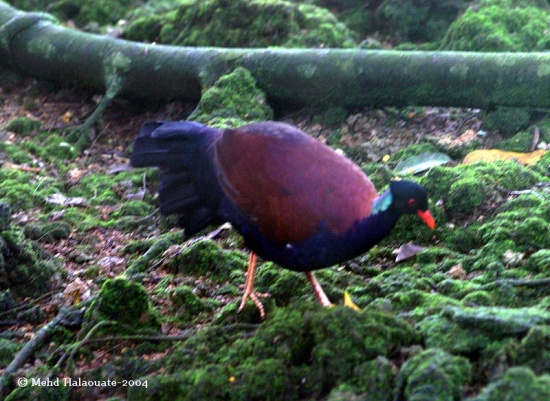Alternative names: Magnificent Ground Pigeon; Magnificent Ground-Pigeon; Magnificent Pheasant-Pigeon; Noble Ground-Pigeon; Green-naped Pheasant-pigeon; White-naped Pheasant-pigeon; Black-naped Pheasant-pigeon; Grey-naped Pheasant-pigeon
- Otidiphaps nobilis
Identification
42–50 cm, 16.5 - 19.7 inches; 500 g.
- Black head and short nuchal crest with green iridescence
- Iris orange to orange-red
- Orbital ring red
- Beak bright red, occasionally tipped orange
- Nape and upper hindneck varies according to subspecies. Iridescent green with a patch of gold or pink and purple below in nobilis
- Mantle and back iridescent reddish purple turning chestnut on secondaries and outerwing coverts
- Lower back dark purple turning blueish on uppertail coverts
- Black breast glossed purple or blueish iridescence
- Black belly with glossy green shine
- Black pheasant-like tail with 20–22 feathers and green iridescence
- Yellowish Long thin legs bright red or purple knee and a thin red line down side of tarsus
- Sexes alike.
- Juvenile duller, mainly greyish black with dark reddish brown above with feathers retaining downy tips for a time
Distribution
New Guinea and nearby islands.
Taxonomy
Subspecies
There are 4 subspecies [1] which some authorities (e.g. [3]) treat as separate species:
- O. n. nobilis: "Green-naped Pheasant-pigeon". Mountains of western New Guinea, Batanta and Waigeo islands
- O. n. aruensis: "White-naped Pheasant-pigeon" has white hindneck, much less coppery nuchal area of mantle, greenish blue breast, slightly paler, less purple mantle and shorter crest. Aru Islands New Guinea
- O. n. cervicalis: "Grey-naped Pheasant-pigeon" has greyish-white hindneck, brown nuchal area of mantle, greenish blue rump and blackish-green underparts. Mountains. of east and southeast New Guinea (Saruwaged, Sepik and Kuper)
- O. n. insularis: "Black-naped Pheasant-pigeon" has no crest, no coloured nuchal patch, wings markedly paler reddish brown than in other subspecies, rump dull purplish, tail base dull greenish, tail and uppertail-coverts dark blue, underparts matt black, with very little iridescence except slight amount of blue or green on breast. Known from 2 specimens collected in 1882, this taxon was filmed for the first time in 2022 [4]. Fergusson Island. (D'Entrecasteaux Archipelago)
Habitat
Mainly in hills up to 1900 m and in lowlands Usually occurs in primary rainforest but sometimes monsoon forest at lower altitudes.
Behaviour
Normally solitary, sometimes in pairs, acts like a pheasant. Resident and sedentary.
Diet
Eats seeds and fallen fruit, sometimes visits display grounds of Wilson's Bird-of-Paradise to search for regurgitated seeds and shows aggressive behaviour towards it. Injests pebbles up to 1 cm in diameter to help digestion. Forages by slow movement along the ground and is known to drink from streams.
Breeding
It is thought to nest on the ground and lay only a single egg.
Vocalisation
Advertising call is a far carrying loud “wu-huwoooaaa” that modulates in pitch with a trailing end. Call lasts 1.4–2 seconds and repeated about 8–10 seconds or more. Male display calls are a “woooou” rising in the middle, and a screeching “crrouwwwwwww”, starting very loudly and lasts about 5 seconds. Calls from perch in the undercanopy and ground.
References
- Clements, J. F., T. S. Schulenberg, M. J. Iliff, D. Roberson, T. A. Fredericks, B. L. Sullivan, and C. L. Wood. 2015. The eBird/Clements checklist of birds of the world: v2015, with updates to August 2015. Downloaded from http://www.birds.cornell.edu/clementschecklist/download/
- Avibase
- Handbook of the Birds of the World Alive (retrieved November 2015)
- See https://news.cornell.edu/stories/2022/11/lost-pigeon-found-after-more-century
Recommended Citation
- BirdForum Opus contributors. (2024) Pheasant Pigeon. In: BirdForum, the forum for wild birds and birding. Retrieved 3 May 2024 from https://www.birdforum.net/opus/Pheasant_Pigeon




